Embodying Virtual Reality Environments: A Conversation with Petra Kuppers
Embodying Virtual Reality Environments: A Conversation with Petra Kuppers
With the first public sharings of early versions of her Just Tech-supported project, Planting Disabled Futures, Just Tech Editor Rodrigo Ugarte and An Doan spoke with 2024 Just Tech Fellow Petra Kuppers. In this conversation, they discuss Kuppers’s first installation, the impetus behind her project, and what participants will experience when they enter the Planting Disabled Futures world. Soon, the installation will be ready to travel and Kuppers and her collaborators look forward to being invited to travel across the country and bring their VR world.
Kuppers is a 2024–2026 Just Tech Fellow and the Anita Gonzalez Collegiate Professor of Performance Studies and Disability Culture at the University of Michigan. A queer, disabled cis woman of size, she is a performance artist and disability activist who uses expanded media and video-dance to celebrate copresence with fellow disabled people, in particular people who live with pain or exhaustion. Her work is driven by principles of access through artful improvisation, awareness of histories of exclusion, and centers disabled people as knowledge carriers and storytellers.
An Doan (AD): Thank you for making the time to speak with us. We’d like to start by hearing more about you and your background. What have you been up to at the University of Michigan, and with your art practice?
Petra Kuppers (PK): I have been engaged in disability culture and media technology since the 1990s, though it was called new media then. I got involved because I had a particular interest in mediated and energetic touch and copresence. I come from a disability culture environment. I’ve been disabled all my life, and I work with people with different kinds of disabilities.
At the time, I had been working in a mental health self-help group in Wales for many years. We met every week, and we went on dream journeys together. We also did physical exercises and dance work. And, again and again, our funders would ask us: “Could we have a show? Could we have some kind of performance? Could we share what we’re doing?” We were doing beautiful, creative, artistic work, but we weren’t really working toward a staged show. It wasn’t that kind of environment. We were quite vulnerable. Many of us had incarceration experiences. Many of us had experienced depo medication, which is when stuff is injected under your skin, and you’re medicated against your will. Many of us had also experienced being unhoused. Some of us did not want to show ourselves on a stage. A lot of us had a form of embodiment that was deeply stigmatized, such as size. Some of us had tardive dyskinesia, a side effect from some of the antipsychotic medication we’d been put on. So, given all these experiences, people didn’t want to go on a stage. I had to figure out what we could do to share the beautiful work we were doing. And, ta-da, how about new media? Instead of just recording ourselves, we came up with a different way of working.
In 1998/1999, we made an installation at a shopping mall in Swansea. You, as an ordinary shopper, walk into the mall—this was when it was normal on a Saturday to just walk around the city and buy your stuff—and there’s this place that invites you to chill out. You walk into this environment, and you read that we are all people with significant mental health differences and other disabilities, and you can come and join us. You can just rest in this space with us. We had three large projection screens around the space. Really, really large, which was unusual at the time. On these screens we appeared lying down and just breathing; our beautiful faces, every face in close-up like jewels in a dark space. Video wasn’t that common yet, and we had shifted the colors a little bit, creating beautiful shimmers. We’re really relaxed, and you hear my voice taking you on a dream journey, going to the bottom of the sea and having a dance. You could choose to stare at us and see whether you could identify our craziness—this was a time when people were really worried about mental health in everyday life—or you could relax and just be with us, breathe with us.
That was the birth of our new media work. It engaged ordinary people. It wasn’t just for an arts crowd. It allowed us to use what was available. Video installations, at that point, felt like a fairly cutting-edge new media technology for community arts in a rural space.
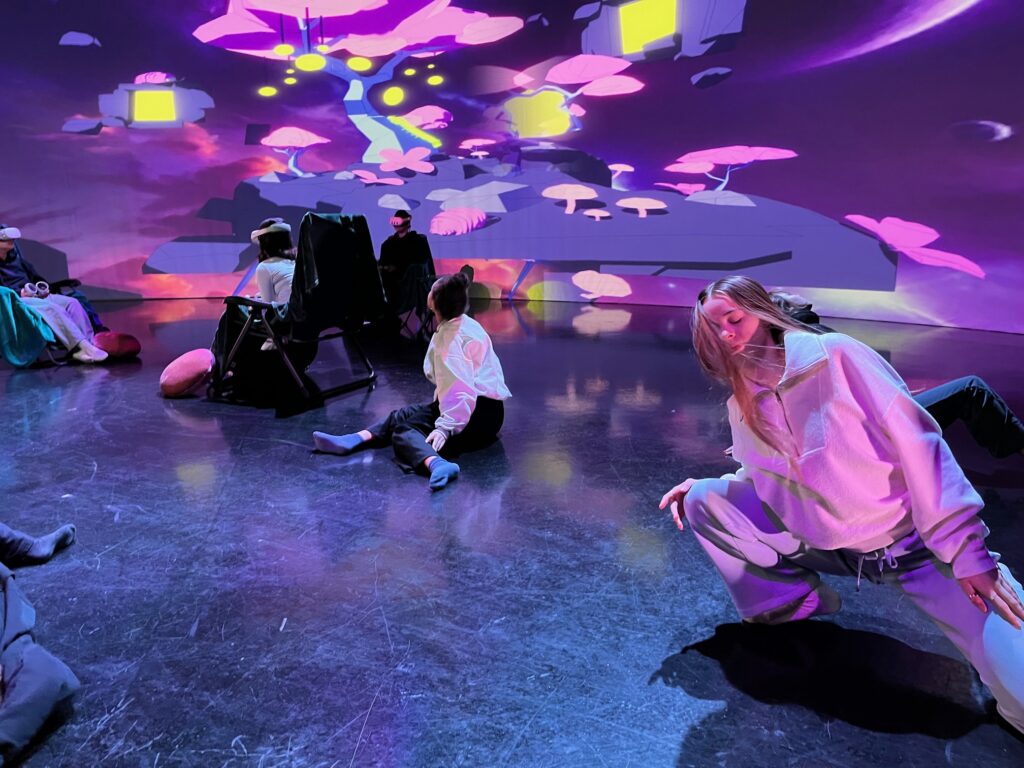
AD: That was a very beautiful story. I think it connects really well with your current Just Tech project that involves VR, Planting Disabled Futures. Why did you pick the VR format? What is drawing you to it?
PK: When you’re in a VR headset, usually it’s a very visual experience. You might be moving your controllers and your arms, and there are some cool exercise applications for headsets that do that, and I use them for my own well-being. I do a lot of somatic work with VR headsets, and that’s the kind of edge that I’m interested in. To give you a sense of why I am doing this, there is an organization called the Disability Visibility Project, and they wrote a join report with Lucasfilm ILMxLab on 79 disabled reality users.
One user explained, “I’m excited by the illusion of traveling free of the confinement of my body. This would hold true for anyone with or without a disability, but virtual reality opens up the possibility of being able to walk in the woods and feel surrounded by trees and the sounds of the forest.”[1]Dominic Brennan, “New Report from ILMxLab & Disability Visibility Project Shares Insights on VR Accessibility Design,” Road to VR, December 6, 2017, … Continue reading
That’s who our project is for: people who wish to dream into transformed futures through both embodied and virtual reality methods. What openings can we create together? How can we think about pleasure, community, activism in immersion with both real plants hanging out at a botanical garden or forest, but also in the virtual reality world? For those of us who cannot easily get to a botanical garden, how can we explore different kinds of intimacies—queer-crip intimacies—in the headset?
Here is where somatics can play a part. Somatics can mean many different things to many different people. To me, it means embodied knowing, an embodied engaged knowing, sensing, feeling. It’s not just something you stare at. It’s just like what I described earlier with the installation in Swansea. Somatic arts affect you bodily, and invite you in as a whole embodied human being. How can I make somatic experiences and political work available for disability culture purposes? How can we create a disability-focused, disability-led intervention into tech arts? Community arts and tech arts have not always been the same. So much tech art is fairly specialized; development needs a lot of cash, often a lot of hardware, and it has a different audience to community arts. My work is about bringing those two together.
Right now, I am spending time with my recording devices, my 360 camera, and all the stuff I took to the Matthaei Botanical Gardens where Turtle Disco gathered recently. Turtle Disco is a somatic writing space I codirect with my spouse, poet, dancer and mad activist, Stephanie Heit, grounded in disability culture. We create local experiences here in Ypsilanti, Michigan, and bring together disabled and queer artists.
Yesterday, we were hanging out in the Gardens with this fun thing, a MIDI device by Playtronica, exploring its affordances. You can connect this little device via a USB cable to your computer or to your phone. And if you have a synthesizer app, you can make sounds, because when you touch the device, your skin’s electricity gets transformed into notes. It’s super fun, and we spent the afternoon touching the device and figuring out that we all make different sounds. Every person’s individual body has a different sound signature.
We also connected this app to the plants in the garden, respectfully and without injury to the plants, and the plants have different sound signatures as well. We then created a soundscape, which is now going to be part of Planting Disabled Futures.
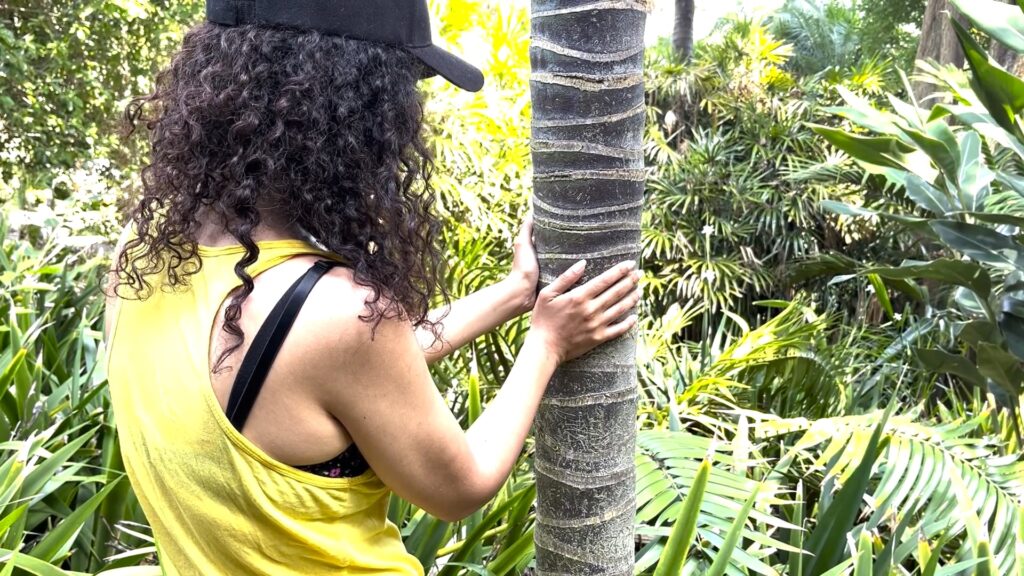
AD: That sounds amazing. You mentioned the disabled community. Can you tell us more about the communities you’re working with, either previously or for this project?
PK: I’ve been working with disabled communities for over 30 years. So, I’ll give you a little bit of a sense of who’s in my community. My wider outfit is called The Olimpias, a name we’ve been using for 30 years now. The name comes from a story by E.T.A. Hoffmann, “The Sandman,” which is about an artificial woman named Olimpia. This artificial woman becomes the projection surface for the men around her, so all the men see something else in this artificial puppet woman. Disability culture feels a little bit like that. People project all kinds of narratives on our bodies when they see us in public, so we played with that. This notion of projection brings together new media technology performance, the dancing woman, and the fact that we, as disabled people, are cultural projection surfaces.
So, the name has been around since 1998, and that’s what I’m using as my general label. We are a loose association of artists from all around the world. It’s not a company per se, but a bunch of people who love playing together. In addition to Olimpias, Stephanie and I run Turtle Disco as the locally grounded component of our joint work. Those are the two labels I operate under.
To be more specific about who is involved in the Planting Disabled Futures project, I’m going to tell you about some of our collaborators. Their bios are available online for everyone to learn more about them. You will see that there’s lots of different people who identify in different ways around disability. Though this can be complicated sometimes. Some of our collaborators are disabled but are not out publicly, though they have come out to me. The reasons for keeping disability private often center around the very real stigma of being disabled, especially in the tech industry.
But one of the many people who are out as disabled in our project is moira williams, who’s doing our haptic work. moira is an Indigenous Lenape artist who lives in what is now called New Jersey, in the Pine Barrens. They are making gorgeous vibro-tactile objects for Planting Disabled Futures.
Then there is Mikel Mwalimu-Banks, our lead musician. Mikel became disabled in 2018, and he is a well-known musician. One of the inspirations for my work is the sound of Sun Ra and the Arkestra, and Sun Ra’s Afrofuturist sound artistry about space journeys. Sun Ra was a jazz and funk musician who was huge in Germany when I was growing up. The amazing thing is that Mikel has a rich and gorgeous Afro-funk and Afrofuturist lineage—he is a 20-year-plus member of Greg Tate’s Burnt Sugar the Arkestra Chamber, and is also a vocalist for the Afro-Tronic band Digital Diaspora. He actually met Sun Ra, too. Now, he kindly created this gorgeous soundscape for our world, in collaboration with Gregory Kage, EM Gong, and Richard Anderson. I am so delighted and honored by this lineage connection to Afrofuturist creation.
Denise Leto is a California-based artist and queer poet who’s a stroke survivor and who has vocal dystonia. She and I have worked on ways of having speech difference represented in interesting ways in the installation.
Alexis Riley, our dramaturge, is a psychiatric survivor. She’s doing really interesting work around access dramaturgy to help us think about how all the different elements can be accessible in their different ways and how that can be its own motor for creativity.
Overall, about 80 percent of the team identifies with disability
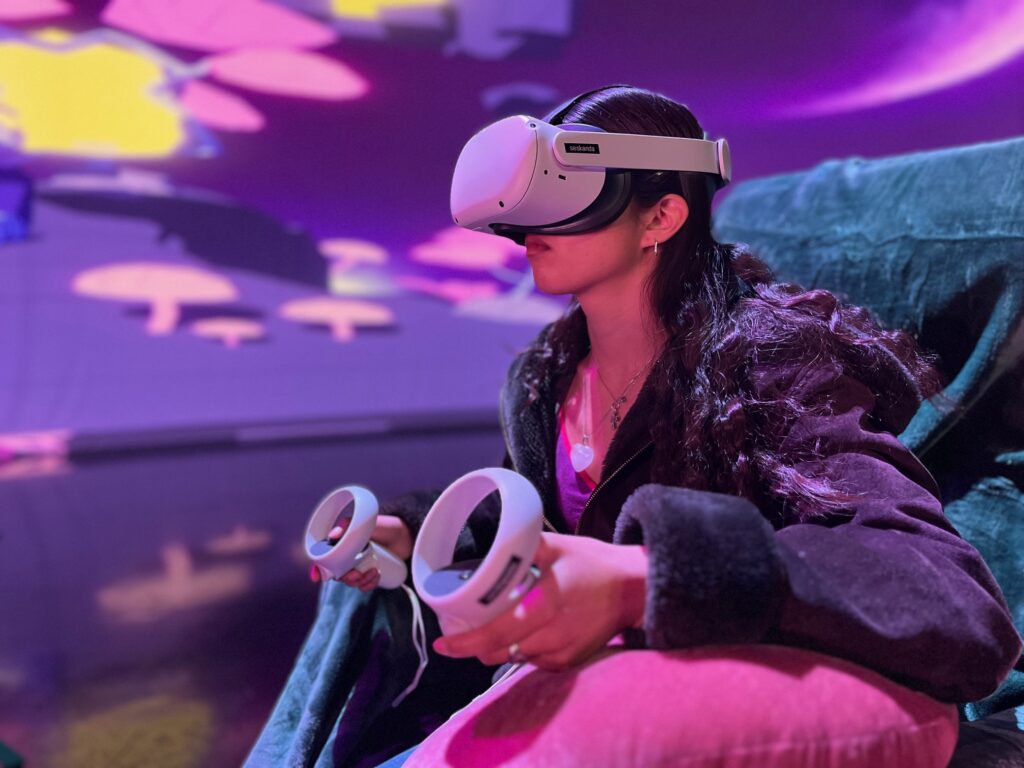
Rodrigo Ugarte (RU): What can one experience through the Planting Disabled Futures project?
PK: Anyone who wants to experience the Planting Disabled Futures world can invite us, and we’ll gladly come to you. Right now, we’re booking community residencies in lots of different places. When you have us come and visit you, we’ll first set up a Crip Cave, which is relatively low tech and doesn’t need a massive space. We usually use locally crowd-sourced deck or camping chairs. We use these deck chairs as places to be comfortable in, where you can choose to sit upright or you can lie down as you go through the experience.
For our initial proof-of-concept installation at the Duderstadt Center at University of Michigan, for example, we had five headsets. But for traveling purposes, we might have two headsets that we bring to you. Many people have never had a headset on, especially in this context, so it can be a really unusual experience. Once people put a headset on, they often don’t know what to do. It can be quite overwhelming. So, we have access doulas in the space. They will greet you and invite you to sit in these camping chairs surrounded by comfy cushions and other soft surfaces, and they then stay with you as you put your headset on and they talk you through it.
The access doulas, which includes myself, can listen to the sounds that the headsets make to give us cues about where people are at so we know what they’re experiencing. We’ve built in ways of helping people along without them necessarily having to tell us lots of stuff. When you enter, you encounter an introduction about the world that we’ve created. “Welcome, dear somanaut. You are a somatic traveler in the imaginative realm of interconnected body-mind-spirit space.” That’s one of the first things you’ll hear. “This is a world of plant elders offering a disability-focused playground of movement and fantasy. As you find your breath and orientation in this world, give thanks to the many creatures that are you. You are the bacteria in your gut. You are the living creatures that nest on your skin. We are all interdependent assemblages.”
As you hear this intro, you see fireflies. They’re orange dots moving all around you with lovely music playing. People really respond very well to it. And then you enter into the tree world itself, gorgeously designed by our lead developer/programmer, Daniel Vincenz, who works for the University of Michigan Emerging Technologies Group. It’s this pink world, in which you can fly around. And again, the access doulas will help you to not just sit there going, “Oh. This is cool. I’m looking around.” We will tell you, “You can now move. You can use the joysticks to move yourself in this space.” Whatever is helpful and supportive.
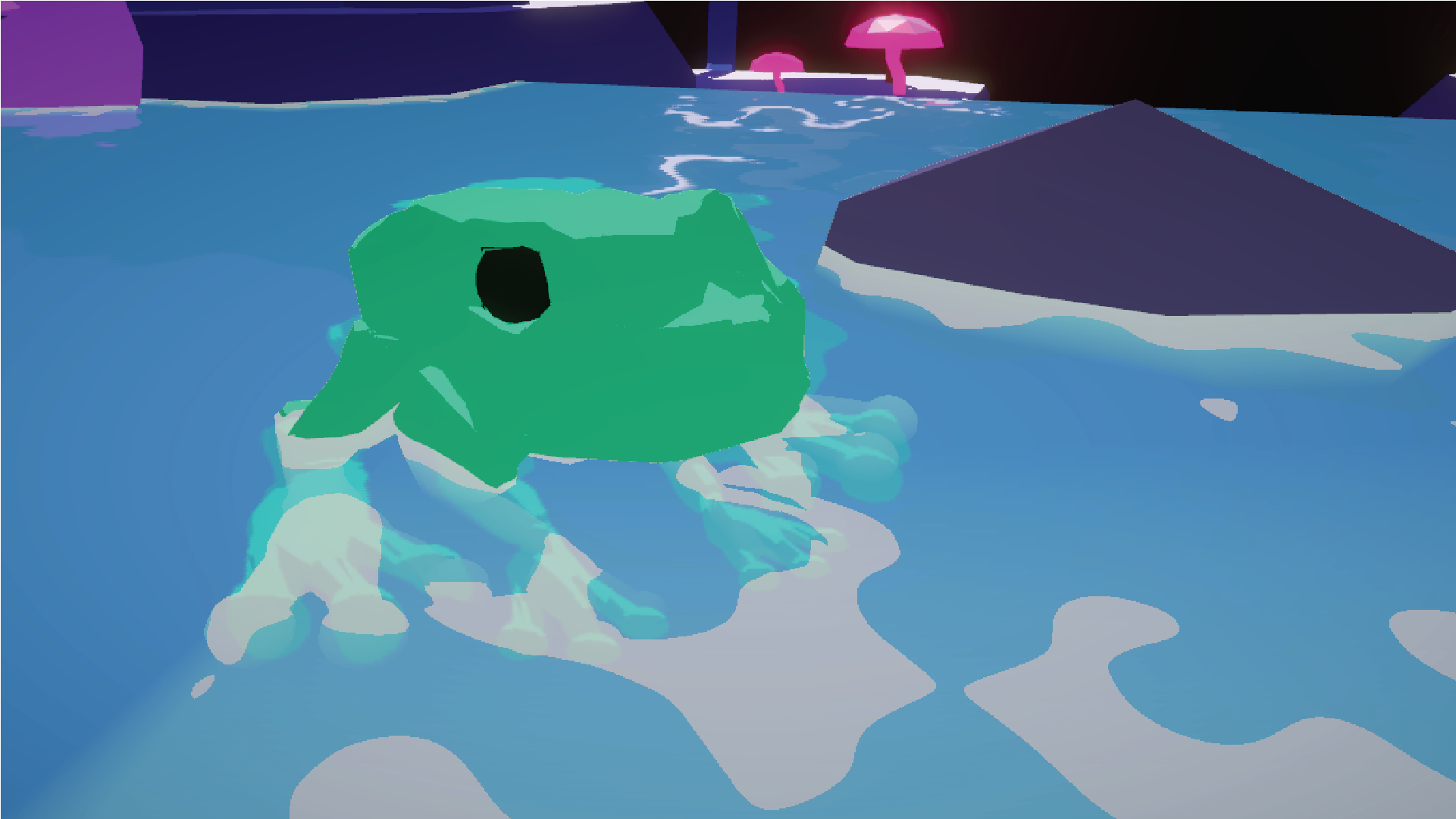
When we started to first share this with people, we had some people just sit there for 10 minutes and loving it, having a really nice time, but not realizing that you can move. This is a 3D world. You can actually move in it. We have all of these sweet critters and some people try to visit them all. They’re very imaginative and gorgeous little disco critters, created by Jason Woodworth-Hou and his students at Georgia Tech. You can also move into portals: 360-degree video scenes of being among plants or videos of disabled people dancing with plants.
In one of these portals, there’s an invitation to have a real object come into the world. So, if you raise your hand at that point, one of the access doulas comes and gives you an object that moira created. It’s like a stimming project. Stimming is a term out of neurodiverse culture, autistic culture. It’s a way of affirming your boundaries by being engaged with textures and colors and sounds. So, this object will be handed to you and you can touch it. You can’t see the object because you’re in this virtual reality world, but you will hear a description of the object while you are touching it, doesn’t that sound fabulous?
AD: It does sound very fabulous.
PK: I think it’s very cool. This is one of the experimental disability features of this project, and it comes out of our collaborative energies. All Olimpias’ experiences, all the work that I’m holding in our tree, are community performances: They’re open, porous to other people’s creativity.
Many of the people in the project who you see listed on my website have, upon my invitation, offered me portal materials. For example, Akhila Vimal, who’s an Indian blind dance artist, is dancing among bamboo. She’s touching the bamboo all around her and she’s audio-describing her experience of touching the bamboo while doing it, talking about it in terms of home. It’s so relaxing. When you are in this portal, you will feel like you are touching the bamboo with your fingers. It’s really very sweet and moving.

Some of the videos have ambient sound, no narration, just somatic experience. At the beginning, there’s an audio description to provide access, and then, for instance, you see a person in a wheelchair playing with a giant leaf, and they’re using their hands to move the leaf and the leaf moves with them. And you just have this minute of a very sweet, small dance between a big leaf and this person.
Other portals emerged from my interest in somatic experiences of sensations. I am interested in the fact that when you stare at a color, when you’re in a color field, your eyes relax and you can see the little floaters in your eyes. You can see yourself seeing. This is an actual bodily experience of being a sensate creature, and I’m trying to activate that. In some of the portals, you just see one color all around you. Wherever you look, it’s just this one beautiful color and you hear a dream journey. You’re going on a dream journey with the scent of petrichor, rock after rain. You think about and feel that, and you become this little creature surrounded by color, scent, and sound.
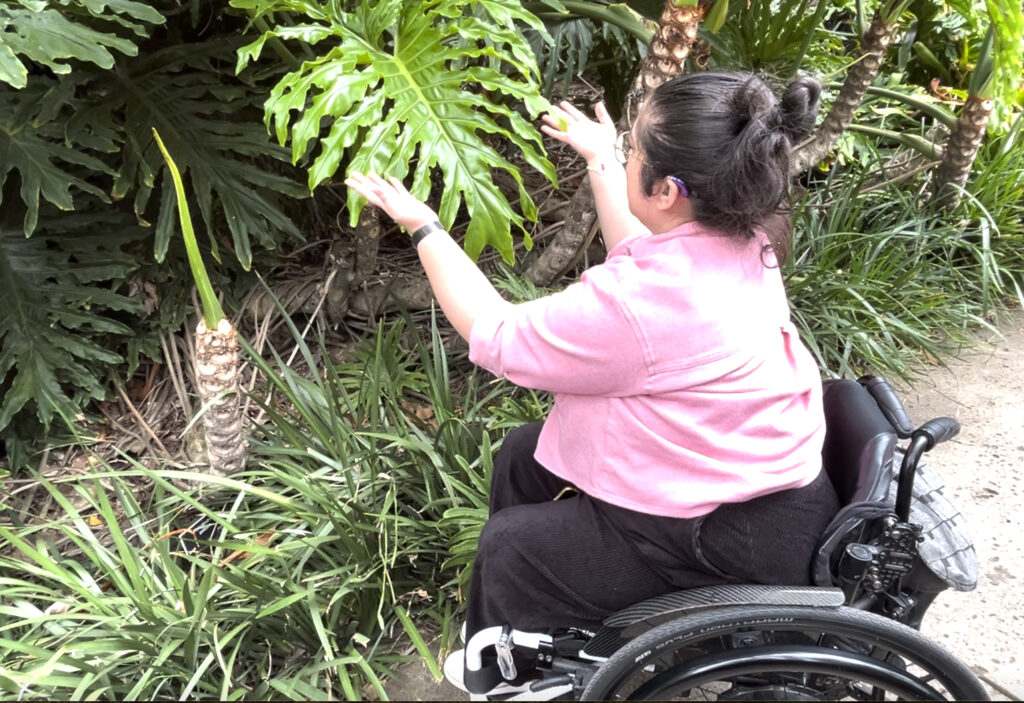
Some of these videos are 360. You’re surrounded by beautiful plants, and you are at the level of the soil. You’re very small. You’re the size of the camera, and you’re looking up and you see the leaves all around you. And you look down and you’re lying on the edge where soil and air meet. And again, there will be a dream journey or a beautiful soundtrack.
When you’re ready, you can leave the experience. In the installation is a table where you can write about your experiences, because it feels like a dream. I always invite people to find a way of holding onto their sensations, either by speaking about it to one of the access doulas or by writing or doodling.
AD: You’ve described the project as being disability-led, but that there are some people who, working in the tech industry, don’t want to be outed as disabled. What insights have you come across that wouldn’t necessarily come out if this project were, say, led by a bunch of able-bodied, White, male tech bros, who make up the majority of the VR development industry?
PK: I think we are engaging access in playful, process-driven ways, not with an eye toward “getting it right,” or being somehow magically fully accessible, but with that beautiful lift of agency, creativity, and play that is central to disability culture and our ways of figuring stuff out together. Let me give you two examples.
Currently, we’re developing an audio-led pathway of floating around this gorgeous pink tree. The visual journey already has all kinds of access built in. It has audio description built, and it has captions everywhere. But we’re now developing an audio-forward track, which is very exciting. We are looking at spatialized audio where you can hear where portals might be and where a form of echo-location allows you to find your way to them
In one of the design charrettes that we’ve had, a nondisabled team-member suggested having participants on a bus, being transported from one portal to the next. Interestingly enough, many of the disabled people on the project said, “No. How about we don’t do that? How about instead, we give people the freedom to choose where they want to go, even if that means that they’re a little bit lost for a while? Because they can deal with that.” We need to balance frustration, the kind of frustration that makes you take your headset off and be done, with the fact that most people don’t want to be directed to everything without any agency. If you as a visual person have access to make choices, then you as an audio-led person should also have choices. So, that’s one of those interesting design crumbs that we are dealing with. I’m not trying to stereotype people into one set or the other, but it was very interesting how disability experiences at that moment became something that allowed us to think differently about how to develop the narrative arc.
One of the other points I want to make about this experience is that it is not a game environment. There’s no game. There’s nothing to be gained. You’re not getting anything extra if you’re going through it fast. It can offer itself to be a very slow experience. It’s aiming for a crip time experience, which means lots of different temporalities. There is no normate way to go through the tree. We had a prototype just a few days ago where we tried it out with about 50 people. They all had the headset on. My dramaturge, Alexis, debriefed every single person to figure out what their experiences were, what we still need to tweak, all that kind of stuff.
What we noticed is that people who are experienced gamers try to get somewhere, try to get some kind of reward. But this is an anticapitalist experience, not a game, so there is no reward. You can just hang out with us. Many people get that, and eventually even the gamers get that, and we just hang out. Most people who came out of the experience talked about how it chilled them out, how it dropped them into a different state. We’re going back to this issue of the somatic embodiment that we talked about earlier. Many people elaborated how they felt themselves just being at rest and being with this world, so that was good. That was a success.
These are two examples of how crip aesthetics shape what we’re doing.
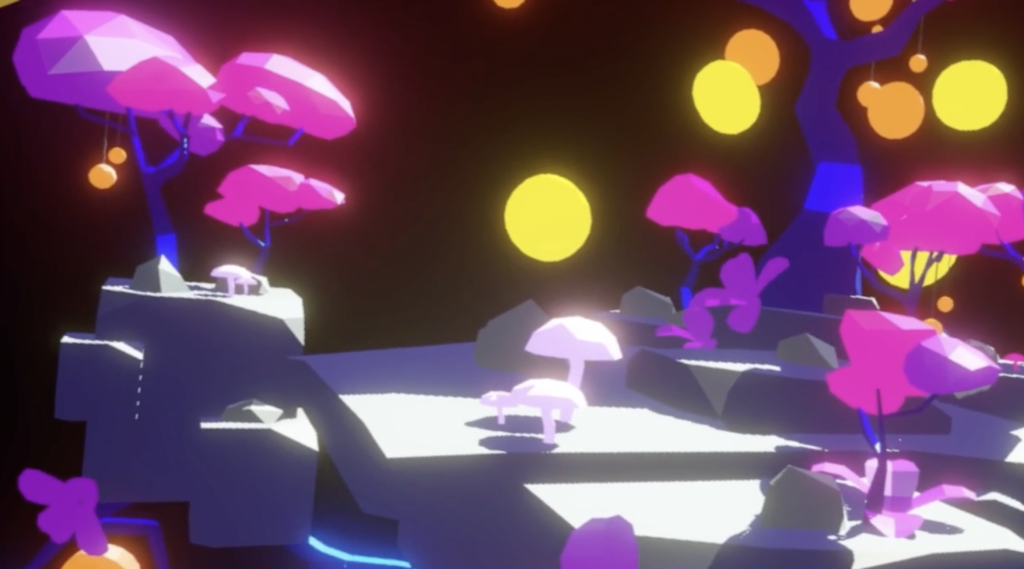
AD: That all sounds so lovely. The Planting Disabled Futures project, at least how you’re describing it and what we’ve seen so far, is a speculative world, but it’s still very much grounded in the natural environment. Your previous work also focuses a lot on the environment and the natural world. What is something people should know about the relationship between technology and the environment?
PK: Certainly, we are using technology to find a way of making ourselves familiar again with natural environments and with the narrative resources and wonder of the natural world. You can hang out under a leaf and just see its gorgeous structure. So that’s a really important issue to me, the wonder of being surrounded by plant elders. That also includes both real plant elders out there in the world as we’re recording them and how plants show up in our cultural imaginations. We have people from different kinds of cultural environments all narrating or performing themselves in relation to plants.
We don’t all share one way of being. I’m German. I come from a place of deep stories about forests and water beings. I come from a very animate world. Belief is not just storytelling, but deep knowledge about being with the animate world. And that’s, of course, something that gets activated for many people in the project as well, which we love. As we’re touring the project, I hope that we can create more portals from the materials that people bring. So, if there’s someone who’s really fascinated, we usually will make a video with them that we will then put into the portal. I was just in San Francisco working at the Exploratorium. While I was out there, I created two new portal experiences with some of my collaborators in the region. Hopefully, this is the way that the touring will work.
But the other aspect of technology is, of course, its extractive nature. The Zoom talk we are having here has a large footprint. The generation of a virtual reality world has a large footprint. One of the things that I’ve been researching since I started the project, just about a year ago, was how we can tune down the processing power required for these immersive worlds if we trust our imagination. So, when you look at our tree world, it’s quite abstract. We’re not trying to go for the kind of hyperrealism that is part of the VR industry.
We are using abstracted geometric shapes. You know exactly what it is, but that’s because you actively are engaged in imagining what this is. We’re not trying to give it all to you in a hyperrealist way. One of the reasons for that is (a) I believe in the agency of people, and (b) it also lowers the energy threshold required to create and maintain this kind of environment. It still is, of course, a virtual reality environment. Writing stories or telling ourselves stories around a campfire would definitely have a lower environmental impact, but I’m trying to balance that within virtual reality.
How realism and virtual reality work is something that’s really interesting to me. How much can we give agency to or rely on the ability, capability, desires of the people who are entering our worlds? We’re finding that we can. People really like this world, even though it is not a hyperrealist forest, and you all know that there are super hyperrealist VR worlds out there. We’re not doing that, not because we can’t do it, but because it’s an aesthetic and environmental choice to have a different kind of environment.
This interview has been edited for length and clarity.
Footnotes
| ↑1 | Dominic Brennan, “New Report from ILMxLab & Disability Visibility Project Shares Insights on VR Accessibility Design,” Road to VR, December 6, 2017, https://www.roadtovr.com/disability-visibility-project-and-ilmxlab-share-lessons-learned-about-vr-accessibility-design/. |
|---|

